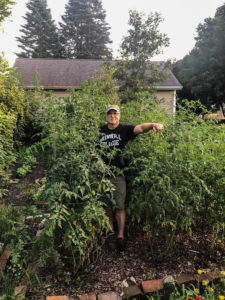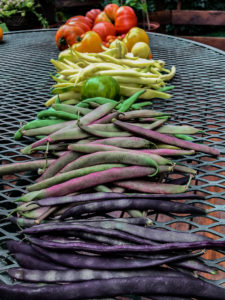By Nora Paul
paulnora@grinnell.edu
In the curlicue vines of the squash plant in his backyard, Professor Todd Armstrong, Russian, feels he has created an ambiance not dissimilar to the Art Nouveau style of the 1920s.
Walking through his garden, he points out different species of flowers, herbs and stems that climb up gnarled branch structures. A central focus of the garden’s composition is its color and aesthetic qualities.
The right edge of the yard teems with tall zinnias, flowers he had selected because of their diverse array of colors and their ability to grow large when trimmed often. He was captivated by them when he first saw them in Bulgaria.
A large portion of what Armstrong grows is from Eastern Europe. He rotates his crops each season and composts all of his organic waste, and does not use any pesticides.
The garden is also influenced by Slavic traditions and Armstrong’s interest in teaching about Russian and Soviet culture through food. “You grow everything for the winter … it’s all about preserving food, and putting away food for the winter, preserving and pickling everything.” said Armstrong.
He buys many of his seeds from the Grinnell Farmer’s Market. Middle Way Farm, which Grinnell alumnus Jordan Sheibel ’09 runs, is an organic community supported agriculture (CSA) farm in Grinnell, Iowa, and is a top choice for Professor Armstrong when he buys his plants locally.
The majority of Iowa’s farmland is used for corn and soybean production for ethanol and other commercial activities, a practice which has overwhelmed smaller farms.
The result of this industrialized monoculture is that most of what is grown in Iowa does not feed the people who live on its own land. Efforts such as community-supported agriculture confront this issue.
“The diversity that’s lacking in [Iowa’s agriculture] is astounding — no, it’s a crisis,” said Armstrong. Armstrong emphasized the importance of teaching people about food waste, organic gardening and thinking about diversity in terms of what we eat. “Our farmers really do feed the world, but how they feed it [is important].”
Armstrong also mentioned his participation in the College garden, which is located across the street from his house.
“I’m really interested in trying to find ways to pull it into the Global Kitchen in the HSSC, because [the student garden] sends all of their food to the dining services, which is great, but it’s just a drip in a pretty big, big bucket,” he said.
Armstrong has used food from his own garden to provide for Russian department events, and imparts portions of his harvest to volunteers and visitors. He said, “Maybe this is a small part of me wanting to push back and put real food into the world.”
He added, “It’s Iowa, things grow here, it’s amazing – why not take advantage of that? We’re constantly making excuses about where we are, rural Iowa. This is one of the wonderful aspects of being in rural Iowa. You can’t grow a garden like this anywhere.”
The prevalence of industrial monoculture in Iowa results in not only a lack of locally-grown food that is easily accessible to its citizens, but a loss of natural prairie. Over 99% of Iowa’s original prairie land has been destroyed. What remains safeguards a piece of Iowa culture and history, and bears environmental and aesthetic significance.
For this reason, much of Iowa’s current prairie land is land that has been restored and protected from interference. 280 acres of restored prairie make up the Conard Environmental Research Area in Grinnell, which is jointly run by the College’s biology department and the Center for Prairie Studies. Professor Lee Running in the art department will be the director of the Center for Prairie Studies next year, upon returning from leave.
Running recalls going to the Conard Environmental Research area, where she brings all of her art classes, and studying the tall prairie grass.
“There’s as much biodiversity in that eight foot space as there is in a canopy in the Pacific Northwest … I’m looking for mountains, but it’s just the size of my body,” she said. “And that suddenly opened up a massive world for me.”
The Western Fringed Prairie Orchid in particular, a flower native to Iowa with blossoms as small as a thumbnail, captivated her attention. “The complexity and intricacy of them is phenomenal and is as exotic as any blooming tree.”
In 2018, using the federally endangered western fringed prairie orchid as inspiration, Running completed an installation in the governor’s office at the Iowa State Capitol, which was on display from January through June. The Iowa Arts Council contacted her to do the site-specific piece.
Running said, “It was really important for me to use the opportunity to put something in the governor’s office that is endangered… and particularly something that has national implications. … I think the rise of corporate monoculture poses one of the biggest questions in the Midwest: what is the land that we really want to live in and is this it? And I think art is an interesting way to ask this question.”
Running looks forward to returning to Grinnell, where she has taught for the last 14 years, and continuing to explore the intersection of art and the environment, and of people and place.
“Teaching in studio, we talk a lot about aesthetics, and I think that often our aesthetics are trained to what we know, and things like the American green lawn came from England. That’s an aesthetic, that’s an European trained garden aesthetic, and isn’t native to this place, but in the way that people love European paintings, we also love European lawns, and some of that is what we’ve been taught, and I’m always curious about ways to expand that conversation; what are different aesthetics, and why is one aesthetic dominant over another?”
Running emphasized that the Conard Environmental Research Area is an outward-facing resource for student and faculty research, education and inquiry regarding the concept of place in Iowa. She hopes that the Center for Prairie Studies can facilitate a relationship between students and the environmental, cultural and agrarian capacities of this place, and grow roots in an Iowan identity that is reinforced by familiarity with native Iowa plant life.
Running said, “I don’t have a romantic vision of that; there’s a lot that is complicated … Everything here has been disturbed. So I don’t want us to romantically look back, but I do want us to look forward with open eyes.”



Correction (9/22/19): The first paragraph of this article read that Professor Todd Armstrong’s garden has an ambiance “not dissimilar to the Art Deco style of the 1920s.” Professor Armstrong reached out to The S&B to amend his statement.
























































The Scarlet and Black • Sep 22, 2019 at 8:40 pm
Todd: Thank you for the correction and for graciously agreeing to be interviewed! We’ve updated the article.
Todd Armstrong • Sep 22, 2019 at 8:32 pm
Thanks for the great article, and I’m honored to be featured along with my good friend and colleague Lee Running! There is one inaccuracy–but not due to the reporter’s error, but rather because I misspoke. Attentive readers and students of art history (and gardening) might find the comparison to art deco a bit odd–and I found myself thinking about it after I read the article. I realized that I had in mind rather art nouveau, a movement inspired by organic form and (a)symmetry.